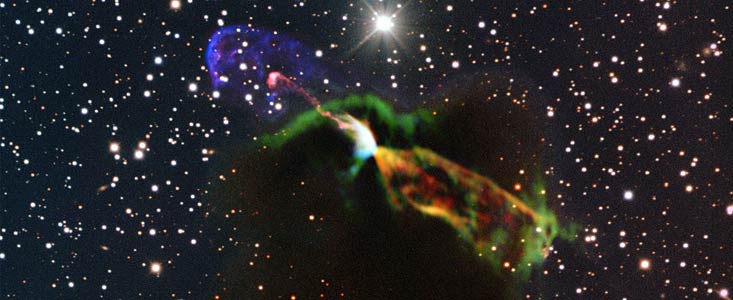Pretty baby
Young star rockets out matter that glows
Share this:
- Share via email (Opens in new window) Email
- Click to share on Facebook (Opens in new window) Facebook
- Click to share on X (Opens in new window) X
- Click to share on Pinterest (Opens in new window) Pinterest
- Click to share on Reddit (Opens in new window) Reddit
- Share to Google Classroom (Opens in new window) Google Classroom
- Click to print (Opens in new window) Print

New images of a young star show that as it’s been bursting to life, it’s also been ejecting material. As this gas slams into a surrounding gas cloud, it causes its neighborhood to glow. A new analysis find that the jets of material this star is spewing move much faster and have more energy than previously thought.
Héctor Arce at Yale University in New Haven, Conn., and his coworkers, observed the baby’s fireworks using two telescopes in Chile. One is a radio telescope known as ALMA (an abbreviation for the Atacama Large Millimeter/submillimeter Array). It consists of 66 antennas arrayed on a flat plateau at an elevation of 5,000 meters (3.1 miles). The other New Technology Telescope collects light from the night sky with a 3.6 meter (11.8 foot) mirror for recording with a precision-guided camera.
As a young star bursts to life, it throws off material at speeds up to 1 million kilometers per hour (620,000 miles per hour). When that material collides with a surrounding cloud of gas and dust, the space region glows. Astronomers refer to this brightly lit cloud as a Herbig-Haro object. Herbig-Haro 46/47 is one that surrounds the newly spotted young star.
They sit about 1,400 light-years away. Arce’s team spotted their unexpected light show as their telescopes were trained on the southern constellation Vela. Ejected star material moving toward Earth (pink and purple, upper left) slammed directly into the surrounding cloud. At the same time, a second jet of material flows out from the star, away from Earth (orange and green, lower right). The scientists also detected an unexpected outflow of matter that is boring another hole through the surrounding cloud. This outflow could be coming from a smaller, neighbor star.
The astronomers describe their new sighting in the Sept. 1 issue of Astrophysical Journal.
Power Words
astronomy The area of science that deals with celestial objects, space and the physical universe as a whole. The scientists who work in this field are known as astronomers. Some who focus on light, energy and other physical phenomena call themselves astrophysicists.
constellation Patterns formed by prominent stars that lie close to each other in the night sky. Modern astronomers divide the sky into 88 constellations, 12 of which (known as the zodiac) lie along the sun’s path through the sky over the course of a year. Cancri, the original Greek name for the constellation Cancer, is one of those 12 zodiac constellations.
star The basic building block from which galaxies are made. Stars develop when gravity compacts clouds of gas. When they become dense enough to sustain nuclear-fusion reactions, stars will emit light and sometimes other forms of electromagnetic radiation. The sun is our closest star.
telescope A light-collecting instrument that makes distant objects appear nearer through the use of lenses or a combination of curved mirrors and lenses. Some, however, collect radio emissions (energy from a different portion of the electromagnetic spectrum) through a network of antennas.






